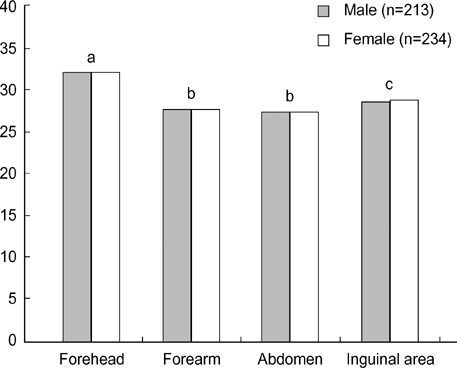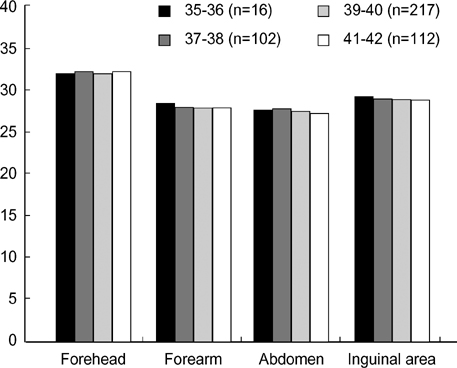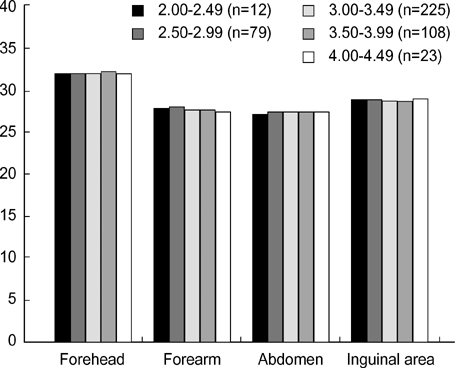J Korean Med Sci.
2005 Feb;20(1):105-108. 10.3346/jkms.2005.20.1.105.
A Study of Skin Color by Melanin Index According to Site, Gestational Age, Birth Weight and Season of Birth in Korean Neonates
- Affiliations
-
- 1Department of Dermatology, College of Medicine, Kyung Hee University, Seoul, Korea. mhlee@khmc.or.kr
- KMID: 1781735
- DOI: http://doi.org/10.3346/jkms.2005.20.1.105
Abstract
- Human skin color shows variations throughout life and influenced by various factors such as race, sex, age and hormones. Since the development of spectrophotometer, many studies on human skin color have been done. However, few studies have been carried out to measure the skin color of neonatal infants. The aim of our study was to assess the variations in skin color according to site, gestational age, birth weight and season of birth in Korean neonates. A total of 447 healthy neonates (3 days after birth, 213 males and 234 females) were enrolled in the present study. Skin pigmentation was measured by reflectance spectrophotometer (Derma-Spectrophotometer(R), Cortex technology, Hadsund, Denmark) at four different sites (forehead, upper arm, abdomen, and inguinal area). The forehead showed highest melanin index in all sites measured (p<0.05). There was no significant difference according to gestational age, birth weight, and season of birth. This result imply that the skin color in neonates is mainly determined genetically.
MeSH Terms
Figure
Reference
-
1. Nordlund JJ, Boissy RE, Hearing VJ, King RA, Ortonne JP. Nordlund JJ, Ortonne JP, editors. The pigmentary system. The normal color of human skin. 1998. 1st ed. New York: Oxford University Press;475–478.
Article2. Anttila VJ, Makela JP, Soininen K, Helminen V, Tenhunen R. Discolouration of skin and serum after sweet ingestion. Lancet. 1993. 5:1476–1477.
Article3. Roberts DF, Kahlon DP. Environmental correlations of skin colour. Ann Hum Biol. 1976. 3:11–22.
Article4. Lock-Andersen J, Wulf HC. Seasonal variation of skin pigmentation. Acta Derm Venereol (Stockh). 1997. 77:219–221.5. Lim TW, Lee MH. A study of skin color by melanin index according to sex, age, site and skin phototype in Koreans. Ann Dermatol. 2002. 14:71–76.
Article6. Roh KY, Kim D, Ha SJ, Ro YJ, Kim JW, Lee HJ. Pigmentation in Koreans: study of the differences from Caucasians in age, gender and seasonal variations. Br J Dermatol. 2001. 144:94–99.
Article7. Esoda EC. Chloasma from progestational oral contraceptives. Arch Dermatol. 1963. 87:486.
Article8. Resnick S. Melasma induced by oral contraceptive drugs. JAMA. 1967. 199:601–605.
Article9. Troilius A, Ljunggren B. Reflectance spectrophotometry in the objective assessment of dye laser treated port-wine stains. Br J Dermatol. 1995. 132:245–250.10. Takiwaki H, Overgaard L, Serup J. Comparison of narrow-band reflectance spectrophotometric and tristimulus colorimetric measurements of skin color. Skin Pharmacol. 1994. 7:217–225.
Article11. Harrison GA. Differences in human pigmentation: measurement, geographic variation, and causes. J Invest Dermatol. 1973. 60:418–426.
Article12. Post PW, Krauss AN, Walcman S, Auld PA. Skin reflectance of newborn infants from 25 to 44 weeks gestational age. Hum Biol. 1976. 48:541–557.13. Walsh RJ. Variation of the melanin content of the skin of New Guinea natives at different ages. J Invest Dermatol. 1964. 42:261–265.14. Grande R, Gutierrez E, Latorre E, Arguelles F. Physiological variations in the pigmentation of newborn infants. Hum Biol. 1994. 66:495–507.15. Frost P. Human skin color: a possible relationship between its sexual dimorphism and its social perception. Perspect Biol Med. 1998. 32:38–58.
Article16. Kahlon DP. Age variation in skin color: a study in Sikh immigrants in Britain. Hum Biol. 1976. 48:419–428.17. Clark P, Stark AE, Walsh RJ, Jardine R, Martin NG. A twin study of skin reflectance. Ann Hum Biol. 1981. 8:529–541.
Article18. Williams-Blangero S, Blangero J. Skin color variation in eastern Nepal. Am J Phys Anthropol. 1991. 85:281–291.
Article19. Ortonne JP. Pigmentary changes of the ageing skin. Br J Dermatol. 1990. 122:Suppl 35. 21–28.
Article
- Full Text Links
- Actions
-
Cited
- CITED
-
- Close
- Share
- Similar articles
-
- A Study of Skin Color by Melanin Index according to Sex, Age, Site and Skin Phototype in Koreans
- Maternal anthropometric measurements and other factors: relation with birth weight of neonates
- Estimation of Fetal Growth by Measurement of Birth Weight for Gestational Age in Newborn
- The significance of nucleated red blood cell counts in low birth weight neonates
- Normal Intraocular Pressure of Neonates Measured with Tono-pen





